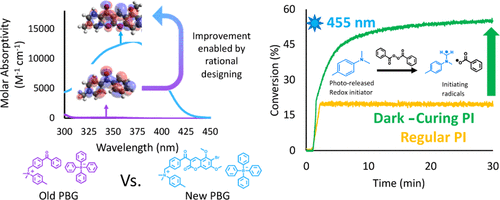当前位置:
X-MOL 学术
›
Macromolecules
›
论文详情
Our official English website, www.x-mol.net, welcomes your
feedback! (Note: you will need to create a separate account there.)
Visible-Light Photoinitiation of (Meth)acrylate Polymerization with Autonomous Post-conversion
Macromolecules ( IF 5.1 ) Pub Date : 2021-08-17 , DOI: 10.1021/acs.macromol.1c00761 Kangmin Kim 1 , Jasmine Sinha 2 , Jeffrey W Stansbury 3 , Charles B Musgrave 4
Macromolecules ( IF 5.1 ) Pub Date : 2021-08-17 , DOI: 10.1021/acs.macromol.1c00761 Kangmin Kim 1 , Jasmine Sinha 2 , Jeffrey W Stansbury 3 , Charles B Musgrave 4
Affiliation

|
Conversion plateaus rapidly in radical photopolymerizations (RPPs) following discontinuation of irradiation due to rapid termination of reactive radicals, which restricts the wider use of RPPs in applications that involve nonuniform light access including those with attenuated light transmission or irregular surfaces. Based on our recent report of a radical dark-curing photoinitiator (DCPI) that continues polymerization beyond the cessation of irradiation by enabling latent redox initiation with photo-released amine in the presence of a suitable oxidant, we developed a new DCPI with an absorption spectrum that extends well into the visible range. Our design process involved a series of computational investigations of candidate molecules, including a systematic study of substituents and their position-dependent effects on absorption characteristics, electronic transitions, and the photochemical mechanism and its associated energetics. Our quantum chemical computations identified the target compound 5,7-dimethoxy-6-bromo-3-aroylcoumarin-DMPT/BPh4 and predicted that it would facilitate the dark-curing mechanism by concurrent photo-radical generation and photo-induced release of an efficient redox reductant under visible irradiation. This reductant-tethered chromophore was then synthesized and optically characterized with UV–vis spectroscopy that revealed its strong visible-light absorption with a molar absorptivity of 5710 M–1 cm–1 at 405 nm and 50 M–1 cm–1 at 455 nm. We then demonstrated extensive dark-curing of >35% additional conversion over 25 min following brief activation of the shelf-stable one-part system by irradiation with a 455 nm LED that was ceased at 20% conversion. In contrast, shuttering irradiation of the control formulation at that same point resulted in immediate cessation of conversion, which plateaued at 20%. We determined a remarkable initiator efficiency of 2.82 that results from the additional redox-generated radicals with a 77% photo-reductant generation quantum yield. The combination of superior photo- and dark-curing efficiencies of this new visible DCPI is expected to open new application opportunities in RPP, especially those involving resins that are highly light attenuating, surfaces that possess irregular features that produce uneven irradiance, and production lines where continued dark-curing downstream of the light activation step enhances line efficiencies.
中文翻译:

(甲基)丙烯酸酯聚合的可见光光引发及自主后转化
由于反应性自由基的快速终止,在停止照射后,自由基光聚合 (RPP) 的转化迅速趋于平稳,这限制了 RPP 在涉及不均匀光进入的应用中的更广泛使用,包括那些光传输衰减或不规则表面的应用。基于我们最近关于自由基暗固化光引发剂 (DCPI) 的报告,该自由基暗固化光引发剂通过在合适的氧化剂存在下利用光释放胺进行潜在氧化还原引发,在停止照射后继续聚合,我们开发了一种具有吸收光谱的新型 DCPI很好地延伸到可见光范围。我们的设计过程涉及对候选分子的一系列计算研究,包括对取代基及其对吸收特性、电子跃迁、光化学机制及其相关能量学的位置依赖性影响的系统研究。我们的量子化学计算确定了目标化合物 5,7-dimethoxy-6-bromo-3-aroylcoumarin-DMPT/BPh 4并预测它将通过同时发生光自由基生成和光诱导释放来促进暗固化机制。可见光照射下的高效氧化还原还原剂。然后合成了这种还原剂束缚的发色团,并通过紫外可见光谱进行光学表征,结果显示其具有很强的可见光吸收能力,405 nm 处的摩尔吸收率为 5710 M –1 cm –1 ,455 nm 处的摩尔吸收率为 50 M –1 cm –1 。然后,我们通过 455 nm LED 照射短暂激活耐储存的单组分系统,并在 20% 转化率时停止,然后在 25 分钟内展示了 >35% 额外转化率的广泛暗固化。 相比之下,在同一点关闭对照制剂的照射会导致转化立即停止,转化率稳定在 20%。我们确定,引发剂效率高达 2.82,这是由额外的氧化还原产生的自由基产生的,光还原剂产生量子产率为 77%。这种新型可见光 DCPI 卓越的光固化和暗固化效率相结合,预计将为 RPP 带来新的应用机会,特别是那些涉及光高度衰减的树脂、具有不规则特征(会产生不均匀辐照度)的表面以及生产线的领域。光激活步骤下游的持续暗固化可提高生产线效率。
更新日期:2021-09-14
中文翻译:

(甲基)丙烯酸酯聚合的可见光光引发及自主后转化
由于反应性自由基的快速终止,在停止照射后,自由基光聚合 (RPP) 的转化迅速趋于平稳,这限制了 RPP 在涉及不均匀光进入的应用中的更广泛使用,包括那些光传输衰减或不规则表面的应用。基于我们最近关于自由基暗固化光引发剂 (DCPI) 的报告,该自由基暗固化光引发剂通过在合适的氧化剂存在下利用光释放胺进行潜在氧化还原引发,在停止照射后继续聚合,我们开发了一种具有吸收光谱的新型 DCPI很好地延伸到可见光范围。我们的设计过程涉及对候选分子的一系列计算研究,包括对取代基及其对吸收特性、电子跃迁、光化学机制及其相关能量学的位置依赖性影响的系统研究。我们的量子化学计算确定了目标化合物 5,7-dimethoxy-6-bromo-3-aroylcoumarin-DMPT/BPh 4并预测它将通过同时发生光自由基生成和光诱导释放来促进暗固化机制。可见光照射下的高效氧化还原还原剂。然后合成了这种还原剂束缚的发色团,并通过紫外可见光谱进行光学表征,结果显示其具有很强的可见光吸收能力,405 nm 处的摩尔吸收率为 5710 M –1 cm –1 ,455 nm 处的摩尔吸收率为 50 M –1 cm –1 。然后,我们通过 455 nm LED 照射短暂激活耐储存的单组分系统,并在 20% 转化率时停止,然后在 25 分钟内展示了 >35% 额外转化率的广泛暗固化。 相比之下,在同一点关闭对照制剂的照射会导致转化立即停止,转化率稳定在 20%。我们确定,引发剂效率高达 2.82,这是由额外的氧化还原产生的自由基产生的,光还原剂产生量子产率为 77%。这种新型可见光 DCPI 卓越的光固化和暗固化效率相结合,预计将为 RPP 带来新的应用机会,特别是那些涉及光高度衰减的树脂、具有不规则特征(会产生不均匀辐照度)的表面以及生产线的领域。光激活步骤下游的持续暗固化可提高生产线效率。











































 京公网安备 11010802027423号
京公网安备 11010802027423号